Average sizes and life expectancy for this breed:
The Alaskan Malamute is often mistaken for the Siberian Husky. While both breeds were built for sledding, Alaskan Malamutes were bred to pull heavy loads over short distances. Conversely, Siberian Huskies were bred to pull lighter loads over long distances. This difference is reflected in their appearance. Alaskan Malamutes are large stocky dogs, famed for their endurance, strength, and devotion to their owners.
The Alaskan Malamute was initially bred by the Mahlemuts, an Inuit tribe from Alaska, to pull heavy sleds across the harsh conditions of the Western Alaskan Arctic. As a result, they boast thick double coats that can withstand extreme cold temperatures. They are also the largest sled dog breed recognised by the UK Kennel Club.
Today, these dogs are beloved for their affectionate, friendly, loyal, and devoted personalities, as well as their impressive ‘wild’ appearance. They have become a popular choice for dog lovers in the United Kingdom and worldwide.
See available puppies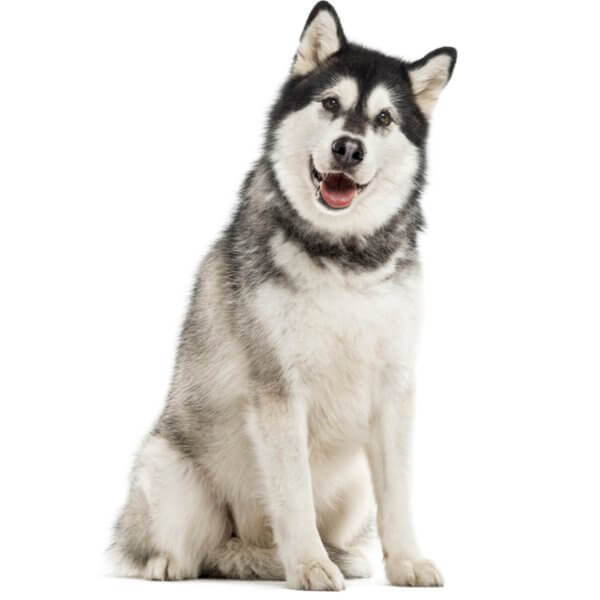

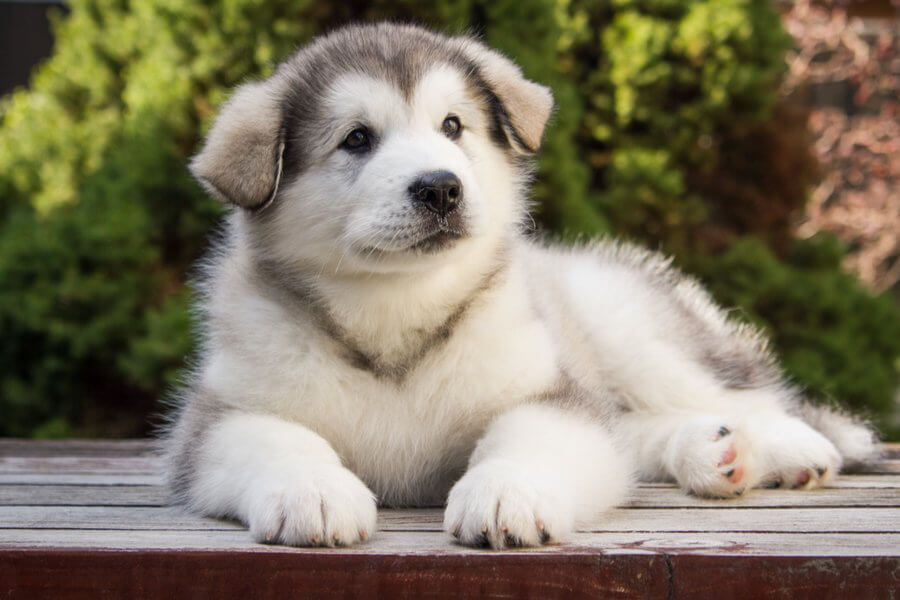


The name 'Malamute' derives from the indigenous Mahlemut tribe of Alaska who used this breed of dog for hunting seals and polar bears, and hauling hunter's heavy loads across the tundra. These dogs were beloved as members of the family by these tribes. In fact, the Mahlemuts are rarely mentioned in early writings without reference to their dogs. For example, a missionary who travelled long distances by dog team wrote:
“These Malamutes are peaceful, happy, hard workers, believe in one wife, are able guides, and have wonderful dogs. They have realized that it is important to have fine animals to pull sledges, that without them, means of travel in this sort of country would be impossible at times.”
During the Gold Rush, the need for sled dogs increased. So, different breeds from outside the region were mixed with native sled dogs to produce different types of quality and substance. This practice almost wiped out the traditional Alaskan Malamute. However, due to the remoteness of the Mahlemut tribe, their dogs remained relatively untainted and pure.
In 1935, the dog breed was officially recognised by the American Kennel Club. The first Malamutes were brought to the UK in 1959. The Alaskan Malamute can be found in the Working Group category of the Kennel Club Breeds. It had a Rare Breed Classification until the Breed was finally granted the allocation of Challenge Certificates in 2006 due to a rise in popularity. In the same year, the Breed gained its 1st Champion.
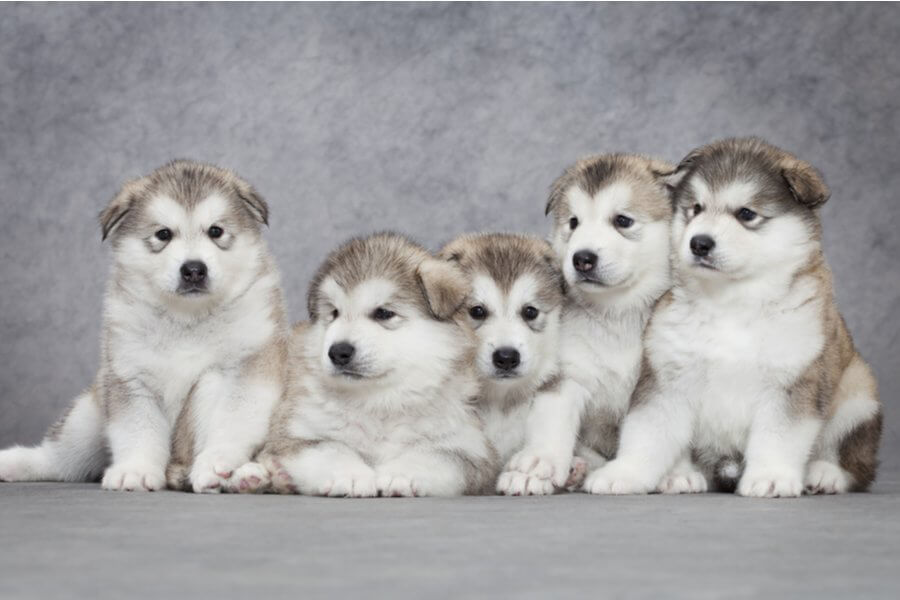
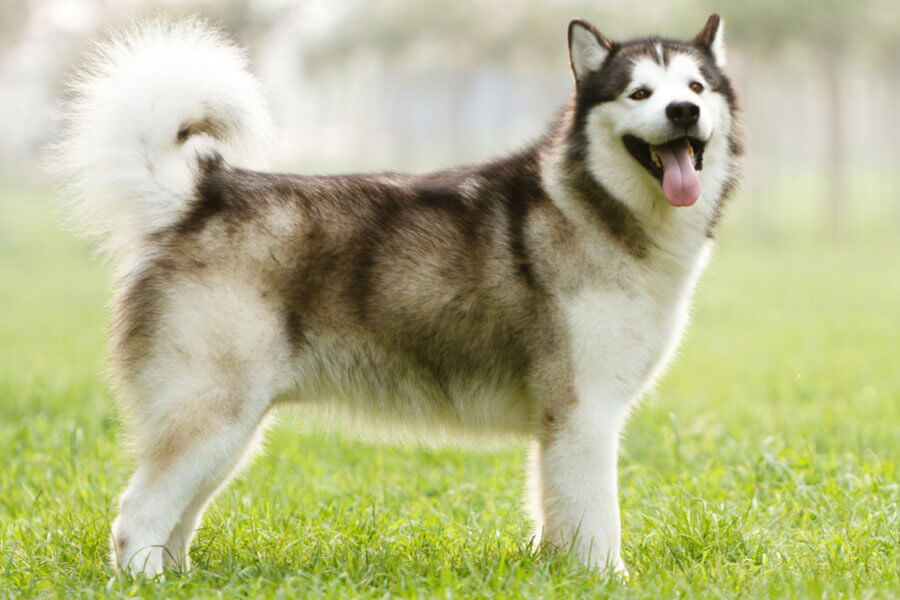
The Alaskan Malamute is a large, robust, and attractive dog. They are heavy-boned, which contributes to their overall impression of strength and endurance. Alaskan Malamutes have large, full heads and broad muzzles that are big in comparison to the size of their skulls. Their eyes are almond-shaped, brown in colour, and medium-sized. However, lighter coated Alaskan Malamutes tend to have lighter coloured eyes, which are allowed under the breed standard. Unlike Siberian Huskies, blue eyes are highly undesirable in this breed.
An Alaskan Malamute’s ears are small in proportion to the size of their heads. Their ears are triangular-shaped with tips that are quite rounded and set wide apart. Alaskan Malamutes have sturdy upper and lower jaws with a perfect scissor bite. Their extremely powerful necks are slightly arched.
Their well-boned shoulders are solid, together with their well-muscled front legs. Their powerful bodies are very muscled, with a straight back that tilts down from their shoulders to their backside. They have strong and well-developed back legs that show off their incredible strength Their large feet are well-rounded, with closed toes and well-arched pads. Alaskan Malamutes have thickly furred tails that are set high and curve upwards.
When it comes to their gorgeous coats, Alaskan Malamutes have an exceptionally thick and coarse outer coat that stands away from the body. They also have a very dense undercoat that is both fluffy and oily - which offers formidable protection from the outside elements. Their guard coat and undercoat can differ in length and thickness across the body. However, generally, the fur is longer around the shoulders, neck, down the back, and around their breeches.
Alaskan Malamutes come in a wide range of coat colours. However, the only solid colour permissible by the UK breed standard is white. Other colours can range from light grey to black, and from gold to shades of red, always combined with white.
Alaskan Malamutes are intelligent and bright. While they are large and remarkable looking, these dogs are very loving and friendly by nature. They are not known to make great watchdogs as they generally greet everyone they meet with the same vigour. These dogs also don’t generally bark to alert. Instead, they make a combination of howls, woos, grumbles, and chirping to display their feelings. They can be very noisy at times, but this can be tamed somewhat with training.
As early as possible, Alaskan Malamutes need to be well-socialised and introduced to as many new people, pets, animals, and circumstances as possible to ensure they grow into well-mannered adults. This dog breed is noted to be very independent and self-sufficient by nature. Saying that, they can shine at many canine sporting activities like weight pulling, canine-cross, agility, rallying, and backpacking if appropriately trained.
Alaskan Malamutes are playful, lively, and cheerful, which are endearing characteristics that they keep throughout their lives. These dogs enjoy being entertained and entertaining their owners with their comical, outgoing personalities.
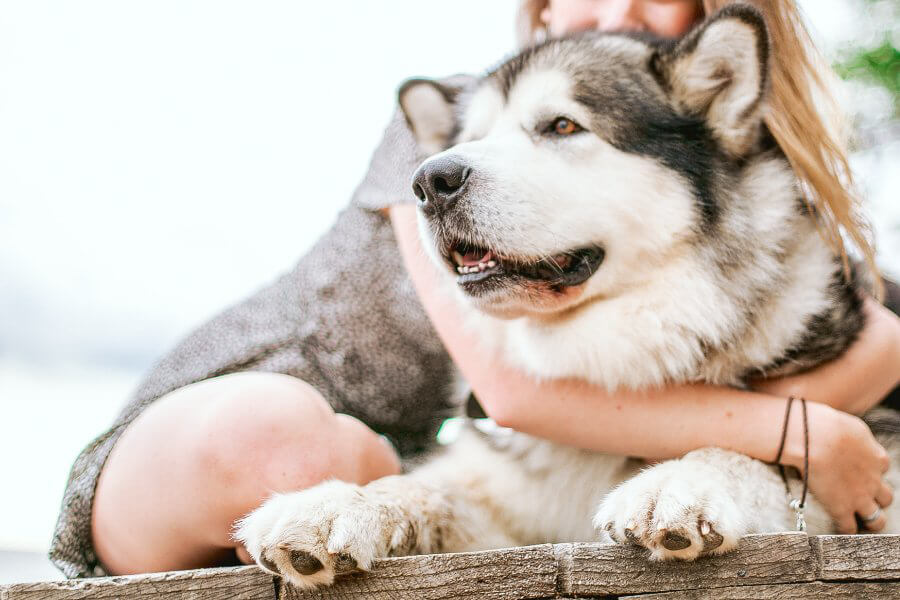
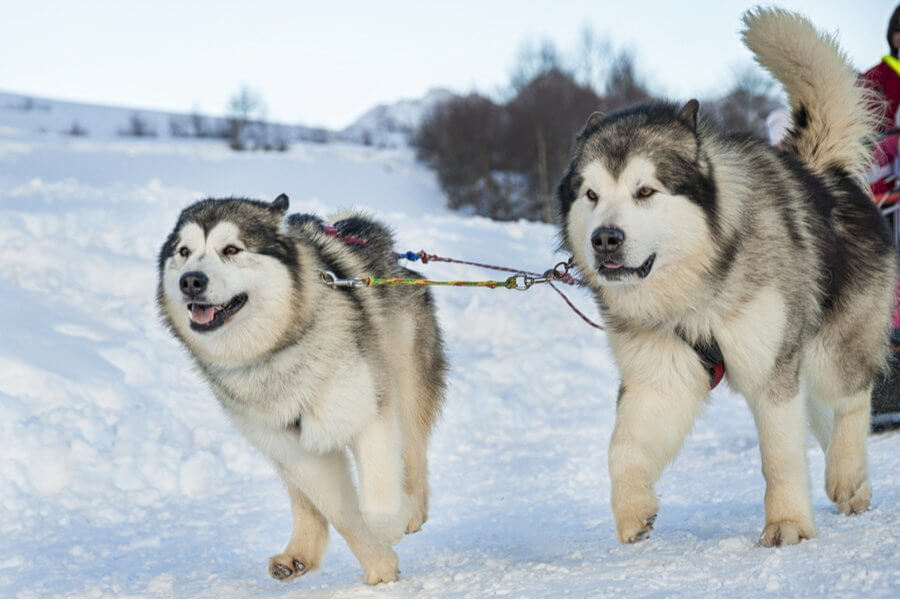
Alaskan Malamutes are known to be a very domineering breed. However, they are also very intelligent. So, they need a firm but gentle hand when it comes to training because they can easily assert their dominance if allowed. Positive reinforcement training works best with this breed, but you must remain consistent! These dogs become bored easily which can lead to the development of destructive behaviours.
Alaskan Malamutes are better matched with dog owners who are familiar with their unique needs and demands. If you are considering adding an Alaskan Malamute to your family, you need to ensure you have ample time to dedicate yourself to this intelligent and independent-thinking dog companion. Otherwise, they will walk all over you!
Like any dog breed, Alaskan Malamutes must be groomed regularly to ensure their beautiful coats and skin stay in good condition. Use a long bristle or slicker brush at least several times a week, making sure you get right into the woolly undercoat. Daily brushing is best to keep shedding under control because these dogs are known to be heavy shedders. You will want to be especially meticulous with your grooming schedule during the Spring and Autumn months when shedding becomes even more prominent. Furminator tools are recommended for this breed because they are excellent at cutting through the coarse guard hairs.
In addition to regular brushing, many Alaskan Malamute owners get their dogs professionally groomed 2-3 times a year. This will make brushing much easier in the long run.
These dogs also require regular bathing once a month or so. However, you need to make sure their coat is fully dried afterward. If you are not experienced in this task, it’s best to get the job done by a professional groomer.
As with all breeds, their ears should be checked and cleaned often to prevent a buildup of wax. You can do this by using a cottonwool ball and a PH-balanced ear cleaner specifically designed for dogs. In addition, their teeth should be brushed daily with a vet-approved toothpaste. If daily brushing isn’t possible, you can brush them 2-3 times a week to prevent tartar build-up. It’s always a good idea to get your dog used to routine tasks such as teeth brushing, nail clipping, and grooming from a young age. Your main aim in the beginning should be to make the jobs fun for everyone involved. As they grow older, they will then become more accepting and won’t attempt to thwart your efforts!
Every time you brush your Alaskan Malamute, you should check for any signs of illness or infection which can include rashes, swellings, abnormal lumps, cuts, and redness. Picking up on these signs early will help you identify any issues before they get too serious.
Remember that Alaskan Malamutes require vigorous daily exercise so they can remain fit and healthy. This will also prevent boredom. Moreover, Alaskan Malamutes need to be fed a good high-quality food that meets all of their nutritional requirements.
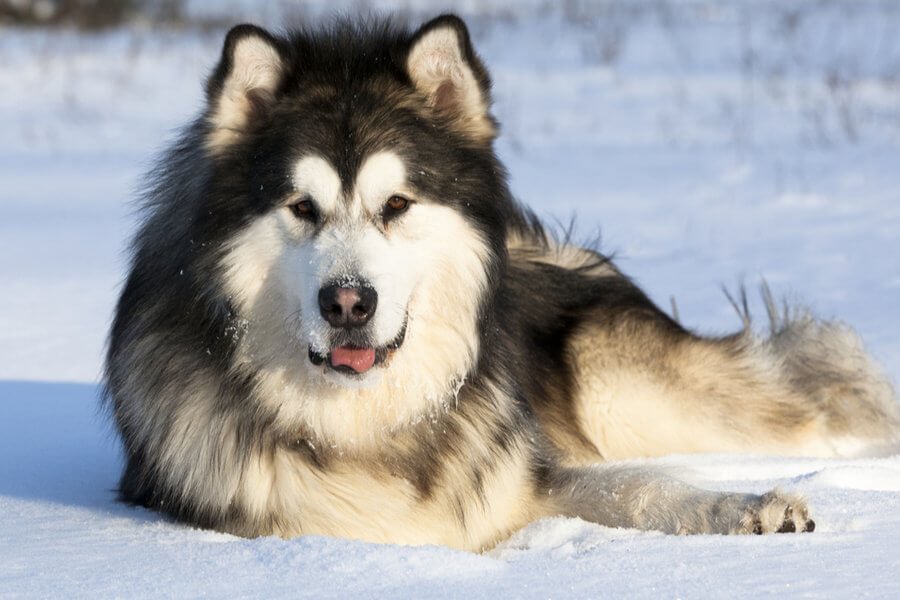
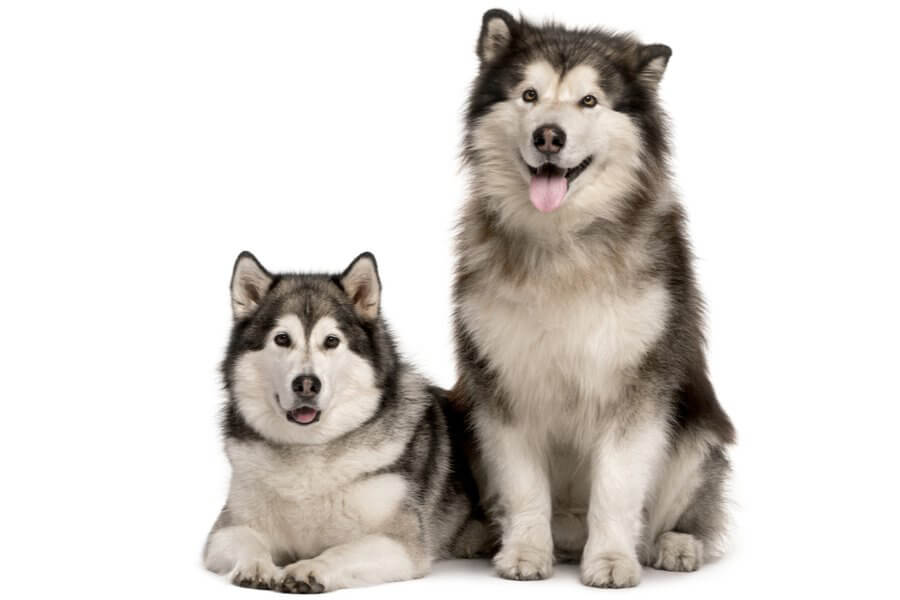
Alaskan Malamutes are one of the oldest dog breeds in the world, so they are known to be fairly healthy and robust. However, like all dogs, they are prone to developing certain health issues. For peace of mind, always purchase an Alaskan Malamute puppy from a licensed breeder to ensure they have been well cared for and appropriately socialized. Your breeder will also be able to perform tests to detect any underlying health concerns. These can include:
Some of the more common health issues seen in Alaskan Malamutes are:
Alaskan Malamutes are not a great choice for people with small children or toddlers because they might be knocked over when these dogs get too excited or playful. Remember that all interactions between a child and a dog should be supervised to ensure no one gets injured.
These dogs are also not best suited to homes with smaller pets such as cats because they have very high prey drives.
Alaskan Malamutes may be a handful, but if they are given all the attention, exercise, and mental stimulation they need, as well as consistent training, they can become much-loved members of the family.
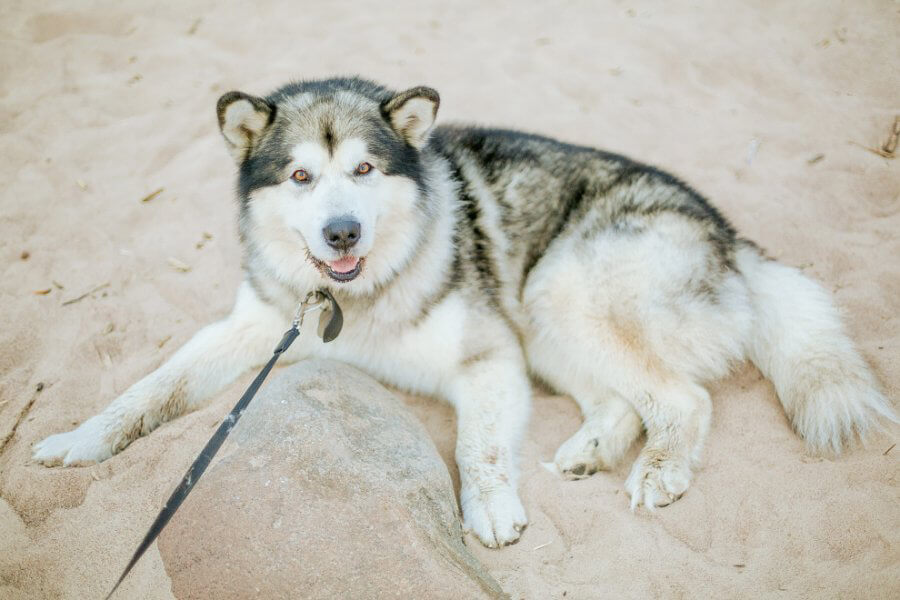

We can connect you with Breeders that are specialized in this particular breed.
See available puppies

Need some advice?
Whether you're a first time pet owner, an experienced pet owner, a new or long-time breeder, or just curious about pets, we've got you covered!

January 17, 2024
What Is The Personality Of Russian Blue Cats?
Russian Blue cats are most known for their distinctive shimmery blue-silver coat and piercing green eyes. However, this breed’s calm and gentle temperament is what makes them shine the most in the feline world.

January 17, 2024
10 Facts About Russian Blue Cat Breed
Russian Blues are one of the most aesthetically stunning cat breeds, with a gorgeous plush silvery coat and vibrant green eyes. However, it’s not only their appearance that is beautiful; their nature is too.

January 17, 2024
How To Choose The Right Cat Breed for You
Cats can make the most fantastic animal companions; they are adorable, friendly, and loving. However, not all felines are created equal. There are many different breeds, of which each has its unique personality traits.
Need some help?
Contact us to speak to our friendly advisor, who will gladly help you find your dream pet!



We are registered in England and Wales under registration number 12568840,
and our registered office is at 58-60 Kensington Church Street, W8 4DB London, England.
© 2023 The Pedigree Paws